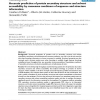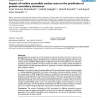28 search results - page 1 / 6 » Accurate prediction of protein secondary structure and solve... |
BMCBI
2007
13 years 4 months ago
2007
Background: Structural properties of proteins such as secondary structure and solvent accessibility contribute to three-dimensional structure prediction, not only in the ab initio...
BMCBI
2008
13 years 4 months ago
2008
Background: Residue depth allows determining how deeply a given residue is buried, in contrast to the solvent accessibility that differentiates between buried and solvent-exposed ...
BIBM
2010
IEEE
13 years 2 months ago
2010
IEEE
ATP is a ubiquitous nucleotide that provides energy for cellular activities, catalyzes chemical reactions, and is involved in cellular signaling. The knowledge of the ATPprotein in...
BMCBI
2010
13 years 4 months ago
2010
Background: It is well known that most of the binding free energy of protein interaction is contributed by a few key hot spot residues. These residues are crucial for understandin...
BMCBI
2008
13 years 4 months ago
2008
Background: The problem of accurate prediction of protein secondary structure continues to be one of the challenging problems in Bioinformatics. It has been previously suggested t...


